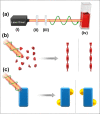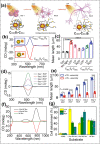Circularly Polarized Light-Enabled Chiral Nanomaterials: From Fabrication to Application
- PMID: 36652114
- PMCID: PMC9849638
- DOI: 10.1007/s40820-022-01005-1
Circularly Polarized Light-Enabled Chiral Nanomaterials: From Fabrication to Application
Abstract
For decades, chiral nanomaterials have been extensively studied because of their extraordinary properties. Chiral nanostructures have attracted a lot of interest because of their potential applications including biosensing, asymmetric catalysis, optical devices, and negative index materials. Circularly polarized light (CPL) is the most attractive source for chirality owing to its high availability, and now it has been used as a chiral source for the preparation of chiral matter. In this review, the recent progress in the field of CPL-enabled chiral nanomaterials is summarized. Firstly, the recent advancements in the fabrication of chiral materials using circularly polarized light are described, focusing on the unique strategies. Secondly, an overview of the potential applications of chiral nanomaterials driven by CPL is provided, with a particular emphasis on biosensing, catalysis, and phototherapy. Finally, a perspective on the challenges in the field of CPL-enabled chiral nanomaterials is given.
Keywords: Application; Chiral; Circularly polarized light; Fabrication; Nanomaterials.
© 2023. The Author(s).
Figures










Similar articles
-
Chiral Carbon Dots: Synthesis and Applications in Circularly Polarized Luminescence, Biosensing and Biology.Chempluschem. 2023 Jan;88(1):e202200428. doi: 10.1002/cplu.202200428. Chempluschem. 2023. PMID: 36680303 Review.
-
Near-infrared circularly polarized luminescence enabled by chiral inorganic nanomaterials.Nanoscale. 2025 Jan 23;17(4):1922-1931. doi: 10.1039/d4nr03743j. Nanoscale. 2025. PMID: 39651574 Review.
-
Recent advances in circularly polarized luminescence of planar chiral organic compounds.Chem Commun (Camb). 2024 Jun 27;60(53):6728-6740. doi: 10.1039/d4cc01698j. Chem Commun (Camb). 2024. PMID: 38884278 Review.
-
Circularly Polarized Luminescence in Nanoassemblies: Generation, Amplification, and Application.Adv Mater. 2020 Oct;32(41):e1900110. doi: 10.1002/adma.201900110. Epub 2019 Aug 8. Adv Mater. 2020. PMID: 31394014 Review.
-
Chiral 2D Perovskites with a High Degree of Circularly Polarized Photoluminescence.ACS Nano. 2019 Mar 26;13(3):3659-3665. doi: 10.1021/acsnano.9b00302. Epub 2019 Mar 15. ACS Nano. 2019. PMID: 30856318
Cited by
-
Maximized circularly polarized luminescence from metal clusters accelerates chiral photopolymerization.Nat Commun. 2025 Jul 25;16(1):6848. doi: 10.1038/s41467-025-62232-9. Nat Commun. 2025. PMID: 40715148 Free PMC article.
-
Amplifying and Reversing the Chiral Bias in Asymmetric Photo-Polymerization Reaction.Adv Sci (Weinh). 2025 Feb;12(5):e2411439. doi: 10.1002/advs.202411439. Epub 2024 Dec 12. Adv Sci (Weinh). 2025. PMID: 39668488 Free PMC article.
-
Clinical observation on the effect of warming meridian medicinal wine, polarized light external application combined with acupuncture and moxibustion on pain after vertebroplasty.J Tradit Chin Med. 2025 Jun;45(3):660-666. doi: 10.19852/j.cnki.jtcm.2025.03.018. J Tradit Chin Med. 2025. PMID: 40524305 Free PMC article. Clinical Trial.
-
Chiral Growth of Gold Horns on Polyhedrons for SERS Identification of Enantiomers and Polarized Light-Induced Photothermal Sterilization.Materials (Basel). 2025 Jun 4;18(11):2627. doi: 10.3390/ma18112627. Materials (Basel). 2025. PMID: 40508623 Free PMC article.
-
Expanding the Horizons of Machine Learning in Nanomaterials to Chiral Nanostructures.Adv Mater. 2024 May;36(18):e2308912. doi: 10.1002/adma.202308912. Epub 2024 Feb 3. Adv Mater. 2024. PMID: 38241607 Free PMC article. Review.
References
-
- Zhao WJ, Zhang WX, Wang RY, Ji YL, Wu XC, et al. Photocontrollable chiral switching and selection in self-assembled plasmonic nanostructure. Adv. Funct. Mater. 2019;29(20):1900587. doi: 10.1002/adfm.201900587. - DOI
-
- Yang G, He CL, Zou G. Synthesis of optically active polymer and structural modulation using circularly polarized light. ACTA Polym. Sin. 2017;11:1725–1738. doi: 10.11777/j.issn1000-3304.2017.17167. - DOI
Publication types
LinkOut - more resources
Full Text Sources
